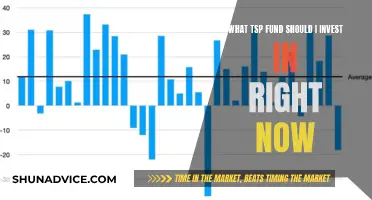
There are two ways to invest in a mutual fund: a traditional one-time investment plan (lump sum investment) and a systematic investment plan (SIP). A one-time investment plan is ideal for seasoned investors who prefer to invest a large sum of money at once during market downturns rather than at regular intervals. On the other hand, SIP is a disciplined form of investment where the investor invests a fixed amount of money at regular intervals, and it is a suitable option for small and individual investors.
| Characteristics | Values |
|---|---|
| Type of investment | One-time investment plan (lump sum investment) or systematic investment plan (SIP) |
| Investor type | Seasoned investors or investors who are new to the stock market |
| Investor knowledge | Investors who are well-versed in the ins and outs of the stock market or those who have limited or no knowledge |
| Investment amount | Large corpus or small amounts |
| Investment horizon | Long-term or short-term |
| Investment objective | Capital appreciation or investment discipline |
| Investment adjustment | Unable to spread investment over the highs and lows of the stock market or able to build a corpus at a steady speed |
| Investment convenience | Relatively more convenient or easier to invest through auto-debit availability |
| Investment charges | Low charges or higher transaction costs |
What You'll Learn

Lump sum vs. SIP
There are two ways to invest in a mutual fund: a one-time investment plan (lump-sum investment) or a systematic investment plan (SIP).
A lump-sum investment is ideal for seasoned investors who prefer to invest a large amount of money in one go during market downturns, rather than at regular intervals. Lump-sum investments are generally made for the long term, which improves the chances of earning higher capital gains.
On the other hand, the SIP mode is generally preferred by investors who would like to invest small amounts at regular intervals. This method helps them build a corpus at a steady speed and is a good option for salaried employees or those new to the workforce.
Advantages of Lump-Sum Investments
- Convenience: Investing via a one-time investment plan is relatively more convenient than an SIP as you pay only once.
- Capital appreciation over time: With the one-time investment plan, the chances of appreciation of wealth increase as the investment has time to adjust to market corrections and grow significantly.
- Low charges: Lump-sum investments generally result in lower transaction costs as they are made for longer durations. Short-term investments often attract higher taxation liabilities and exit loads.
Disadvantages of Lump-Sum Investments
- Undisciplined investment: Lump-sum investment plans do not encourage investment discipline.
- No investment adjustment: With a one-time investment plan, an investor cannot spread their investment over the highs and lows of the stock market. Thus, they are exposed to a greater degree of risk of not being able to bounce back from an investment decision made at the wrong time.
Advantages of SIPs
- Solves the timing problem: Since SIPs mean regularly investing a fixed sum regardless of the market level, investors automatically buy more units when the markets are low. This results in a lower average price, which translates to higher returns.
- Solves the investment interval problem: SIPs help people stay invested through the ups and downs of the market. When the market falls, investors with an SIP strategy continue to invest, which is the correct approach. This is achieved by automating the process of investing regularly, eliminating the mental load of deciding when to invest.
Disadvantages of SIPs
In a drifting equity market, SIPs are not always the best option.
Mutual Fund Investors: Owners of a Diverse Portfolio
You may want to see also

Ideal for seasoned investors
There are two ways of investing in a mutual fund scheme: the traditional one-time investment plan (lump sum investment) and the systematic investment plan (SIP). The former is ideal for seasoned investors who are well-versed with the ins and outs of the stock market and are comfortable investing a large sum of money in one go. Such investors often prefer to invest in the direct plan of a mutual fund scheme.
Lump-sum investments are generally made for longer terms, improving the chances of earning higher capital gains over time. They are also more convenient than SIPs as you only pay once, and your investment can grow. In addition, lump-sum investments generally result in lower transaction costs as they are made for longer durations. However, they do not encourage investment discipline and can expose investors to a greater degree of risk if the investment decision is made at the wrong time.
When considering a one-time investment plan, it is important to assess the market's valuation before making a lump-sum investment. Checking the Price-to-Earnings (P/E) ratio of a broad market index can give you an idea of the current market valuation. You should also analyse the factsheet of the mutual fund scheme to understand the potential returns and liquidity expectations. Finally, patience is key when investing in mutual funds. It is important to give your investment enough time to grow instead of exiting the scheme due to short-term negative market movements.
Mutual Fund Secrets: Uncover PRI Investment Opportunities
You may want to see also

Long-term gains
Long-term investing in mutual funds can be a great way to secure your financial future. Here are some key points to consider for long-term gains:
Lump Sum vs. Systematic Investment
There are two main ways to invest in mutual funds: a traditional one-time investment plan (lump sum investment) and a systematic investment plan (SIP). Lump-sum investments are ideal for seasoned investors who prefer to invest a large amount at once during market downturns. These investors are usually well-versed in the stock market and are comfortable with taking on more risk. On the other hand, SIPs are more suitable for new investors or those who prefer to invest smaller amounts at regular intervals, gradually building their investment portfolio.
Advantages of Lump Sum Investments
Lump-sum investments offer convenience as you only need to pay once and let your investment grow. They also provide better capital appreciation over time since the investment can adjust to market corrections and grow significantly. Additionally, lump-sum investments generally have lower transaction costs as they are made for longer durations, avoiding short-term exit loads and higher taxation liabilities.
Disadvantages of Lump Sum Investments
One of the drawbacks of lump-sum investments is the lack of investment discipline. With a lump sum, investors cannot spread their investment over time and may face a greater risk of not being able to recover from a decision made at the wrong time, such as buying fewer units during bullish runs due to higher prices.
Factors to Consider for Long-Term Gains
When considering long-term gains through mutual funds, it's important to assess the market's valuation before making a lump-sum investment. Check the Price-to-Earnings (P/E) ratio of a broad market index to get an idea of the current market valuation. It's also crucial to estimate potential returns and liquidity expectations by analysing the factsheet of the mutual fund scheme. Patience is key in long-term investing, allowing your investment sufficient time to grow instead of exiting prematurely due to short-term market movements.
Types of Mutual Funds for Long-Term Gains
When investing in mutual funds for the long term, consider the following types:
- Stock Funds: These funds offer a collection of stocks unified by a specific theme or categorization, such as American stocks or large-cap stocks. They provide diversification and are less risky than investing in individual stocks.
- Bond Funds: Bond funds are ideal for investors seeking a diversified portfolio of bonds without the need to analyse and buy individual bonds. They are considered safer than stocks, and by investing in a variety of bond types and issuers, the impact of any one bond defaulting is lessened.
- Dividend Stocks: Dividend stocks are those that pay regular cash payouts, often found among more mature companies. They are popular among older investors as they provide a steady income, and some companies even increase their dividends annually.
- Value Stocks: Value stocks are cheaper on certain valuation metrics, such as the price-earnings ratio, making them attractive when interest rates are rising. They tend to have less downside potential, making them a lower-risk option.
- Target-Date Funds: These funds automatically adjust their asset allocation to become more conservative as you approach retirement, ensuring your portfolio is safer when you need the money.
- Real Estate: While real estate investing requires a significant amount of money to start and comes with high commissions, it can be a great long-term investment. It offers the potential for high returns if you select the right property and manage it well.
- Small-Cap Stocks: Investing in small-cap stocks, or stocks of relatively small companies, gives you the opportunity to capitalise on emerging markets and find hidden gems with high growth potential. However, small-cap stocks tend to be more volatile and riskier than larger, established firms.
- Robo-Advisor Portfolios: Robo-advisors build a diversified investment portfolio for you based on your goals, time horizon, and risk tolerance. They offer a hands-off approach to investing and can be customised to your risk preferences.
- Roth IRA: A Roth IRA is a tax-advantaged retirement account that allows you to save with after-tax money, grow it tax-free, and make tax-free withdrawals in retirement. It's a great option for those looking to maximise their tax-free retirement savings.
Remember, when investing for the long term, it's crucial to understand the risks, pick a strategy that aligns with your goals and risk tolerance, know your time horizon, and ensure your investments are diversified.
Loaded Fee Mutual Funds: When to Invest and Why
You may want to see also

High-risk strategy
High-risk mutual funds are designed for investors who are willing to take on more risk in exchange for the potential for higher returns. These funds typically invest in stocks or equity with a higher risk of losing value but also a higher potential for growth. Here are some key considerations for a high-risk strategy in mutual funds:
Volatility and Risk-Reward Ratio
High-risk mutual funds are more volatile than other types of mutual funds, meaning the value of your investment can fluctuate significantly over time. While these funds carry a higher level of risk, they also offer the potential for sizeable returns. The best high-risk mutual funds aim to balance this risk-reward dynamic.
Investment Horizon
High-risk mutual funds require a long-term investment horizon, typically at least 5-10 years. This longer time frame allows investors to ride out market fluctuations and benefit from compounding returns. Investors with a shorter investment horizon may not have sufficient time to recover from potential losses.
Diversification
High-risk mutual funds may diversify their portfolio by investing in a range of assets, including stocks, bonds, commodities, and real estate. This diversification helps to spread risk across different sectors and asset classes, potentially reducing overall portfolio volatility. However, it's important to note that high-risk funds primarily invest in stocks or bonds of developing or growing companies, which tend to be more volatile.
Professional Management
High-risk mutual funds are typically actively managed by experienced fund managers who have expertise in investing in high-growth companies. These professionals actively monitor market trends, conduct research, and adjust the portfolio allocations to make more informed investment decisions.
Taxation
When investing in high-risk mutual funds, it's important to consider the tax implications. In some countries, such as India, short-term capital gains tax and long-term capital gains tax may apply, depending on the holding period. Additionally, dividend payouts from high-risk mutual funds may attract tax deductions.
Suitability
High-risk mutual funds are most suitable for investors with a strong understanding of the market and macroeconomic trends. These investors also have a high-risk appetite and are comfortable with exposing their portfolio to volatility in pursuit of higher returns. It's crucial for investors to assess their risk tolerance and financial goals before investing in high-risk funds.
Investment Modes
Investors can choose between two main investment modes when investing in high-risk mutual funds: Systematic Investment Plan (SIP) and lump sum. SIP allows investors to contribute a fixed amount at regular intervals, while lump sum requires investing a specific amount at once. SIP is generally more suitable for those who want to invest smaller amounts over time, while lump sum is preferred by seasoned investors who are comfortable investing a large sum at once.
Closed-End Funds: Registered Investment Companies Explained
You may want to see also

Requires market knowledge
Investing in mutual funds requires some knowledge of the market. There are two main ways to invest in mutual funds: a traditional one-time investment plan (lump-sum investment) and a systematic investment plan (SIP). Both have their own advantages and disadvantages, and the choice between the two depends on the investor's financial goals, risk tolerance, and market knowledge.
A one-time investment plan is more suitable for seasoned investors who are well-versed in the stock market and can invest a large sum of money at once. These investors usually have a good understanding of market dynamics and are comfortable with taking on higher risks. The main advantage of a one-time investment plan is the potential for higher capital gains over the long term. However, this option does not encourage investment discipline, and investors may be exposed to a greater degree of risk if they make investment decisions at the wrong time. Therefore, it is crucial for investors choosing this option to assess the market's valuation before investing.
On the other hand, a systematic investment plan (SIP) is more suitable for beginners or those with limited knowledge of the stock market. SIP allows investors to invest small amounts of money at regular intervals, helping them build a corpus steadily over time. This option is often preferred by salaried employees or those who are new to the workforce. SIP offers the benefit of rupee cost averaging and encourages regular investment. However, it is important to note that the money flows out every month until the end of the tenor in the case of SIP, which may result in lower returns compared to a one-time investment.
In conclusion, while both options have their advantages, investing in mutual funds does require some level of market knowledge. Seasoned investors with a higher risk appetite may prefer the one-time investment plan, while beginners or those with limited knowledge may opt for the more disciplined and steady approach of a systematic investment plan (SIP).
Emergency Fund Strategies: Philippines Investment Options
You may want to see also







